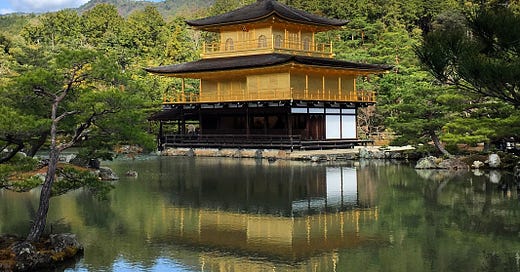That Cheap Japan Trip Is About to Get Pricier
Plus, a wild new Philippe Starck hotel, the demise of Lonely Planet, Italian passport difficulties, and Spain's jellyfish problem.
A few years ago I was one of the first travel journalists to visit Bhutan after it reopened from COVID. Whether because of the pristine nature, the picturesque Bhutanese architecture, the ever-present phalluses, one of the best hotels I’ve ever stayed at, or constantly finding chilis in all my dishes, it was a memorable trip.
While there, though, everybody I talked to in the tourism industry was in a state of alarm. As part of its reopening, the government had jacked up its “Sustainable Development Fee” to $200 per person, per day. It made Bhutan—already immensely difficult to get to if you don’t have a private plane—arguably the most expensive country to visit. While that increased fee would likely have brought stable revenue for the government while keeping crowds low, thousands of people who worked as tour guides, waiters, or in hotels that catered to budget-conscious or even middle-class tourists were out of luck.
That massive fee stayed in place for roughly a year, when the Bhutanese government instituted its first modification ($200 a day for the first seven days, and then $0 for the following seven). Last May, it went further and cut the entire thing in half to $100 a day, where it currently stands, and will remain unless the number of yearly tourists surpasses 300,000. Then it will move the price back up.
I bring up Bhutan because as many loyal readers of this newsletter know, places that suffer from overtourism have been gingerly testing out ways to both raise money for their citizens and curb the crowds. For the most part, those efforts have been timid. For instance, Venice started out with a five euro fee for daytrippers that it has now doubled to 10. Hotel/tourist taxes in major European cities like Paris and Barcelona are going up but at relatively modest amounts.
But now Kyoto is taking a Bhutan-style plunge.
Last week it passed an ordinance increasing the occupancy tax on high-end categories of hotels by ten times the current fee. If your room costs ¥100,000 or more (roughly $690 a night), you’ll now pay $69 per person per night, and that $138 a night extra for a couple comes on top of the consumption tax and service charge. If you’re spending between ¥50,000 and ¥100,000 ($340ish to $690ish), your nightly fee is roughly $28 a person. So a mid-range couple is now spending $60 extra a night. This new tax also applies to bookings made with points.
That’s a lot of money, and Kyoto is expecting to double its revenue as a result of it. And Kyoto has always suffered more than anywhere else in Japan. Thanks to a recently favorable exchange rate leading to a historic boom in travel from the U.S., the plague of overtourism has gotten worse.
Unlike Bhutan, though, I don’t think that this increase will decrease tourism overall. I do, however, think it could hurt overnight tourism from everybody except the very wealthy, for whom the increases are a rounding error.
The unfortunate thing for Kyoto is that I think this will increase the number of day trippers from nearby Osaka. Which will do nothing for the crowds that plague the city, will still hurt hotel owners, and incentivize the worst kinds of tourism.
DEPARTMENT OF GRIEVANCES
I think I’m obsessed with Philippe Starck’s newest hotel which just opened in Metz, France. It’s a nine-story hotel (Maison Heler Metz) and part of Hilton’s Curio Collection. On top of the tower is a metal-clad mansion that Starck designed with a fictional person in mind. Now, we’ve all seen or heard designers talk about some imaginary person that they conjured up to find inspiration, but in this case, Starck actually wrote a novel about this “Manfred Heler” and it’s on sale now with Allary Editions!


There is a massive line between being somebody who pushes, bends, or even breaks nonsensical rules while traveling, and a person who is an asshole like the American arrested this week in India because he went to a restricted island that is home to an uncontacted tribe carrying a coconut and Diet Coke. (Uncontacted tribes around the world are protected both because exposure to modern diseases could wipe them out and also to preserve their way of life.) The island in this case was part of the Andaman Islands, a chain off the coast of Burma belonging to India. Back in 2018, this same tribe (the Sentinelese) killed an American missionary who tried to land and make contact.
A big part of United’s game plan is differentiation via international destinations that other mainline carriers aren’t going to. A couple of years ago that was Majorca, and this fall that was Palermo, Bilbao, Madeira Island, Faro, and Dakar. Now, the airline is adding flights to Adelaide, Ho Chi Minh City, and Bangkok. In releases, United noted it's the only U.S. carrier to offer flights to Bangkok and Ho Chi Minh City—but there’s a catch. They connect first in Hong Kong. Now, maybe folks who are die-hard United loyalists are excited about this. You already have to connect to get to these cities, so why not do so on an airline where you have status? But it isn’t terribly exciting for me. It is, however, a chance to go down the tangent of why there are no direct flights to Thailand from the U.S. Part of it is regulatory. A few years ago, the U.S. government downgraded Thailand’s aviation safety rating which meant Thai airlines couldn’t add flights to the U.S. And since Thai Airways stopped flying direct back in 2015, there couldn’t be any movement on the Thai front. The reason it shut down the flights is that they were losing money, so one hopes that this new era of Americans desperate to travel abroad means that when the routes are brought back, it’s for good.
Alongside sharks and pulling a Depardieu on a plane, carbon monoxide poisoning (in the news because of Miller Gardner’s death) remains one of my overpowering irrational fears while traveling. If a rental has an operable window, I’m always leaving one open a crack somewhere in the apartment.
I refuse to become another travel writer looking down my nose at the cruise industry. It’s beloved for a reason and also the only way to travel for a lot of people who can’t fly. That said, any time one of these stories about a mass outbreak of Norovirus happens it reinforces that I will not be going on one any time soon.
Readers over the age of, 28 I guess, will find this profile on the demise of Lonely Planet by Business Insider fascinating.
TRAVEL INDUSTRY NEWS
The New York Times got a preview of Universal’s new Epic Universe and came away impressed
Italy just made it a lot harder to get its passport for people of Italian descent
The EU is giving away thousands of rail passes to young people
Spain’s islands are having a jellyfish surge
Bali bans menstruating tourists from visiting temples
A new ruling makes it more likely we’ll see Eurostar competitors in near future
The Real ID deadline is looming and millions still don’t have it







Hi William! As a first time reader, I was excited to see we share the love for Bhutan and it's absolutely amazing Gangtey Lodge in Wangdue Phodrang.
They use chilis since they're born- in their babies bottles if they could. It's the first thing I saw drying on the roofs, as the ground careened towards me the first time I landed in Paro-- almost nose dived, I should say 22 yrs ago.
My hard currency at the time, plus my ex's guilty conscience bought me a full month in my happy place. I trekked, I went to Tsechus, I traversed, I fell in love with the Kingdom and its people.
It really doesn't take a private plane. There are many more connections nowadays, I was back in 2023- but still it's a hefty sum in plane tickets + hours flying+ the daily levy + surplus for any of the fancy shmancy hotels. Matt Dutile photographer extraordinaire swears that Wherever to Delhi-Paro remains the shortest. I prefer Wherever - BKK- Paro or SIN-Paro.
But take me from Wherever to Bhutan anytime, anywhere. Specially now. Even in a cruise ship😄